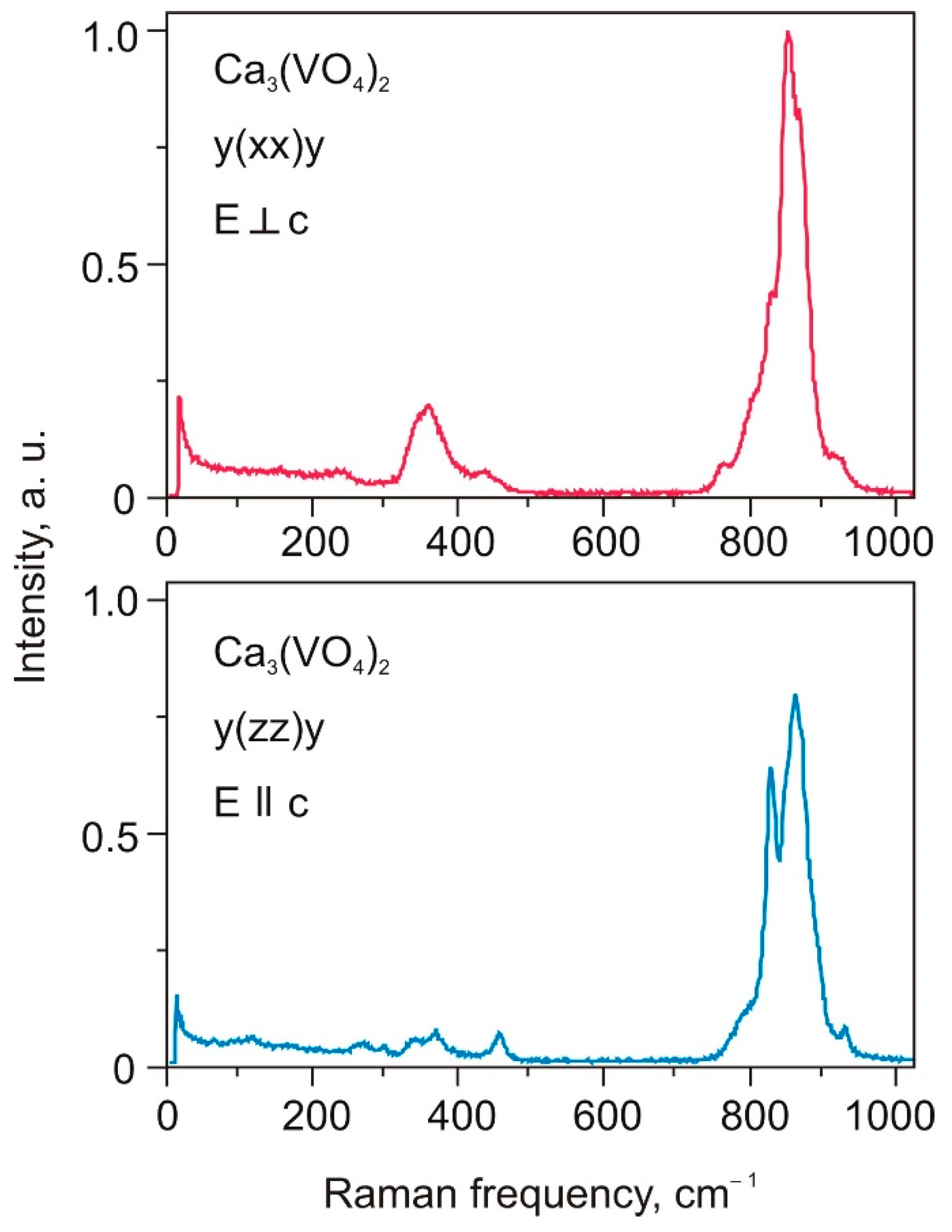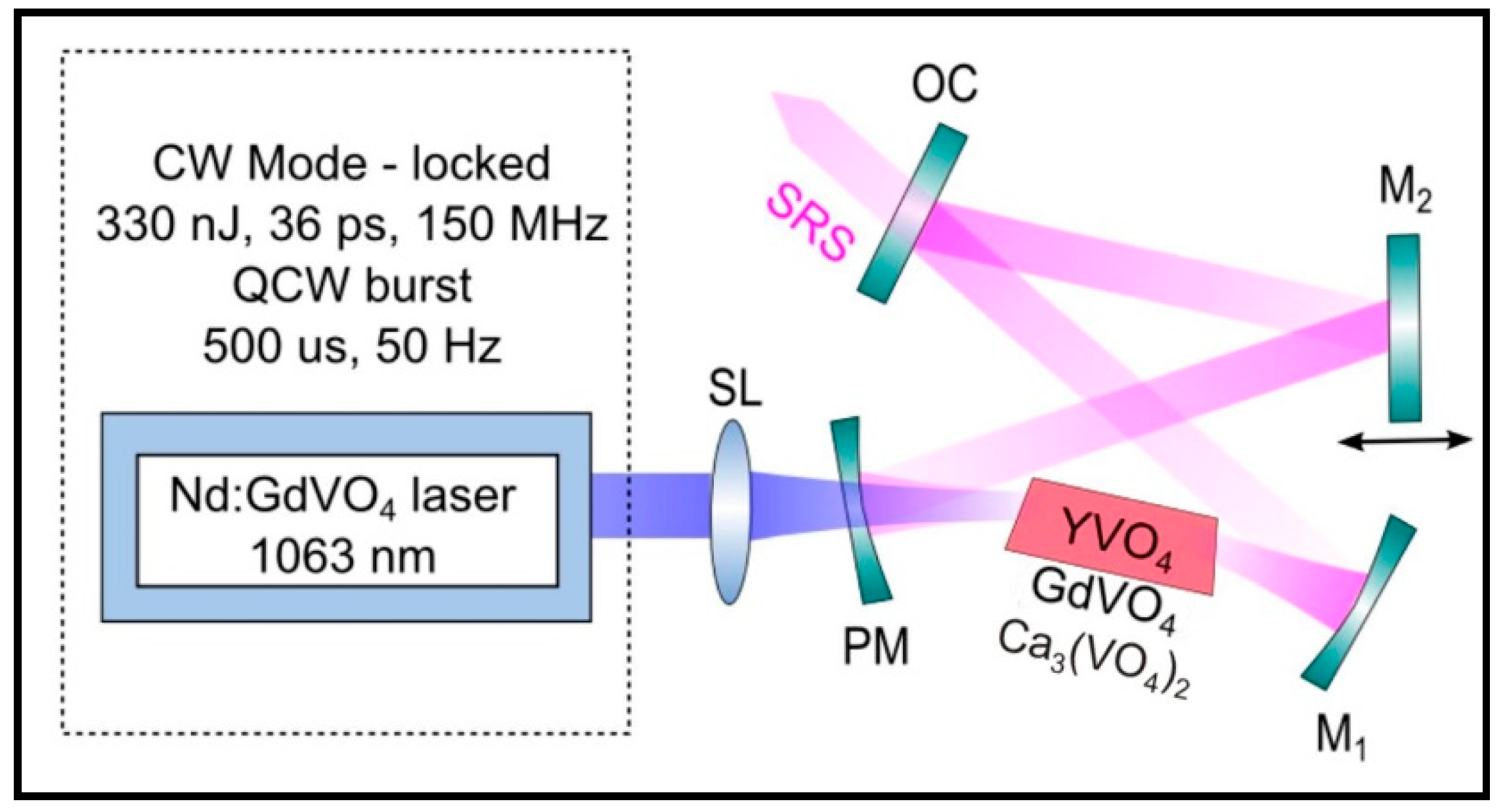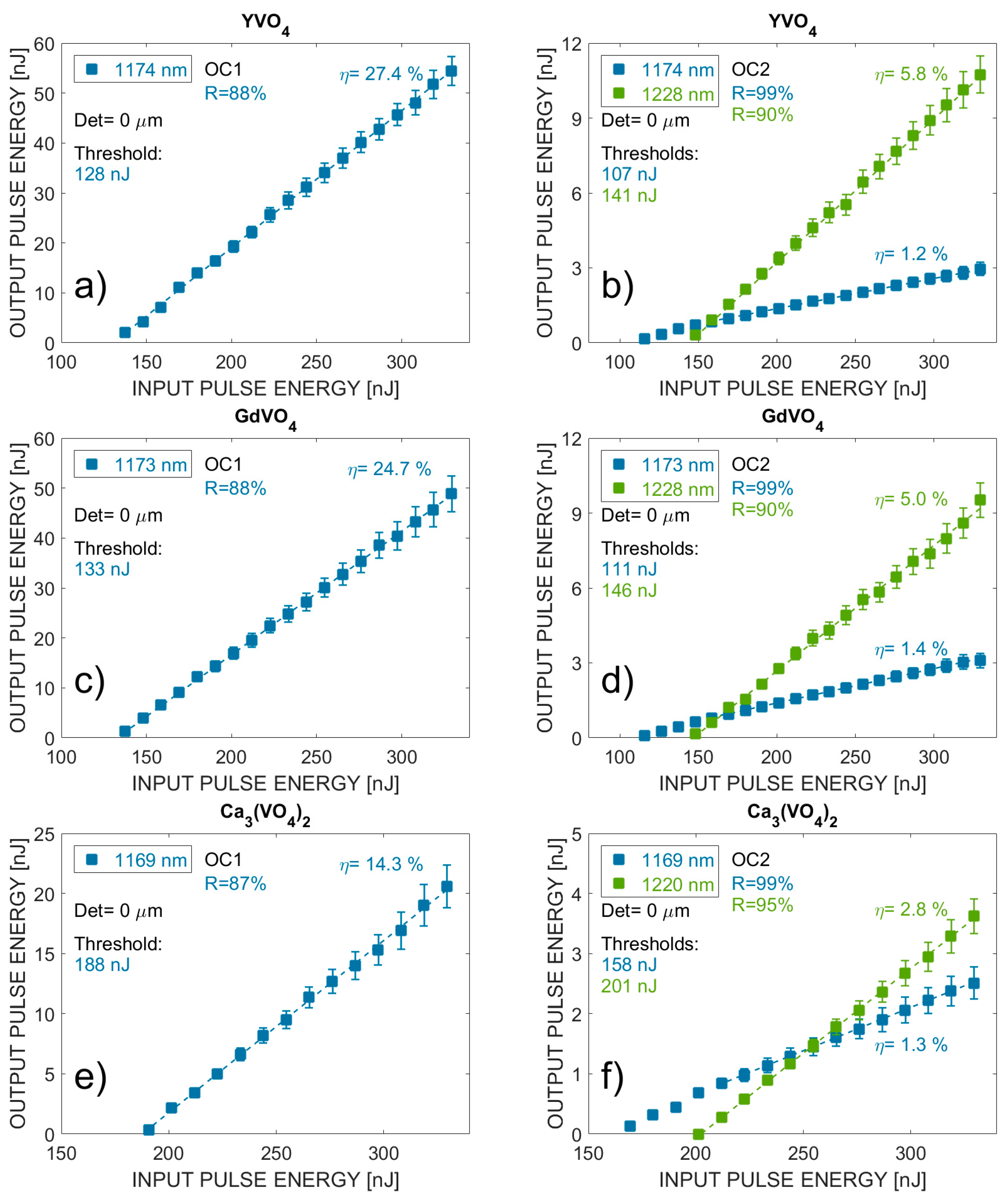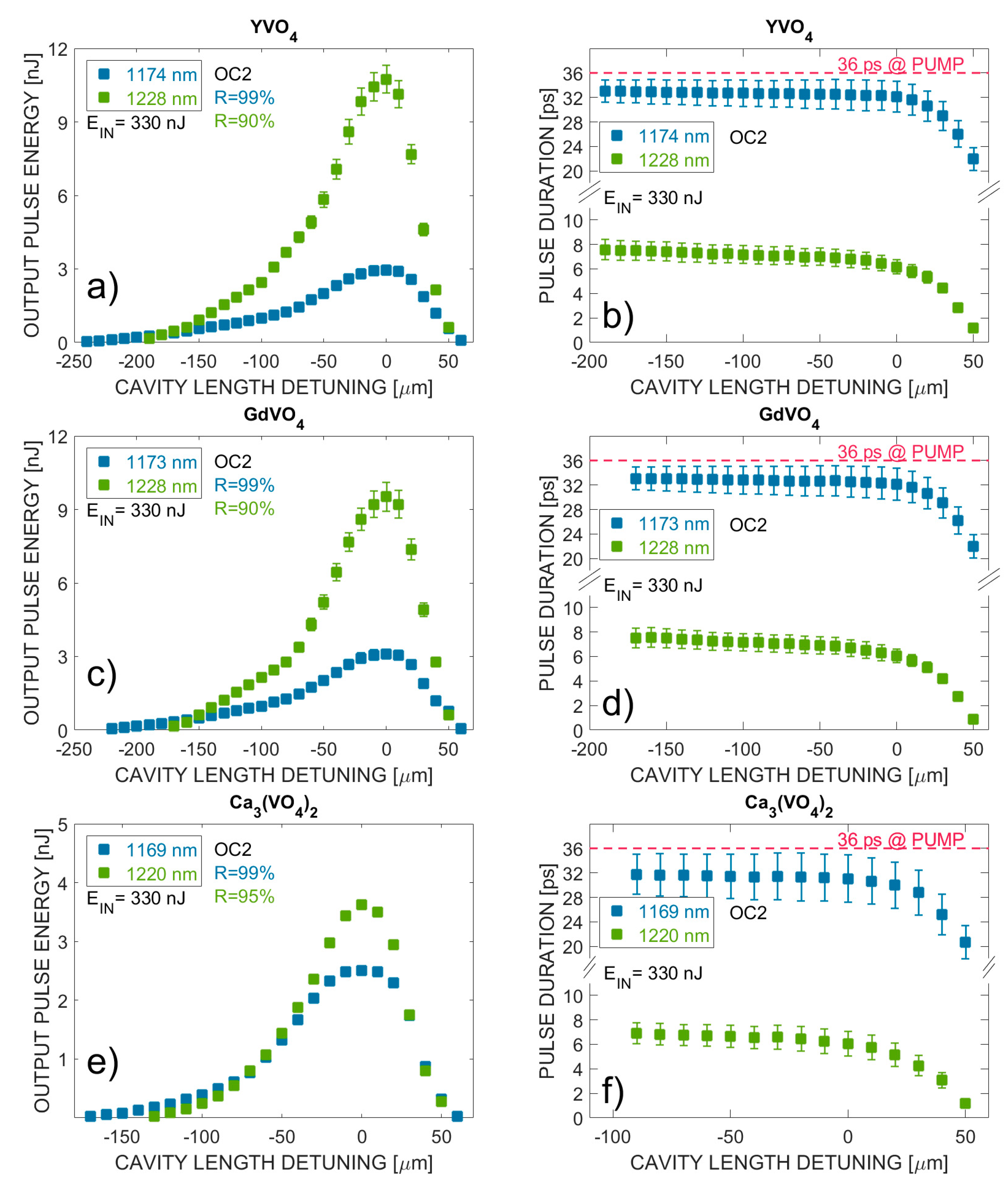Stimulated Raman Scattering in Yttrium, Gadolinium, and Calcium Orthovanadate Crystals with Single and Combined Frequency Shifts under Synchronous Picosecond Pumping for Sub-Picosecond or Multi-Wavelength Generation around 1.2 µm
Abstract
:1. Introduction
2. Raman Crystals Characterization
3. Experimental Setup
4. Perfect Synchronization Case
5. Cavity Length Detuning for the Strongest Pulse Shortening
6. Conclusions
Author Contributions
Funding
Conflicts of Interest
References
- Zagumennyi, A.I.; Mikhailov, V.A.; Shcherbakov, I.A. Rare earth ion lasers—Nd3+. In Handbook of Laser Technology and Applications, Volume II: Laser Design and Laser Systems; Institute of Physics Publishing: Bristol, PA, USA, 2004. [Google Scholar]
- Ivleva, L.I.; Dunaeva, E.E.; Voronina, I.S.; Doroshenko, M.E.; Papashvili, A.G.; Šulc, J.; Kratochvíl, J.; Jelínková, H. Impact of Tm3+/Ho3+ co-doping on spectroscopic and laser properties of Ca3(VO4)2 single crystal. J. Cryst. Growth 2019, 513, 10–14. [Google Scholar] [CrossRef]
- Kaminskii, A.A.; Ueda, K.I.; Eichler, H.J.; Kuwano, Y.; Kouta, H.; Bagaev, S.N.; Chyba, T.H.; Barnes, J.C.; Gad, G.M.A.; Murai, T.; et al. Tetragonal vanadates YVO4 and GdVO4—New efficient χ(3) materials for Raman lasers. Opt. Commun. 2001, 194, 201–206. [Google Scholar] [CrossRef]
- Zverev, P.G.; Karasik, A.Y.; Basiev, T.T.; Ivleva, L.I.; Osiko, V.V. Stimulated Raman scattering of picosecond pulses in SrMoO4 and Ca3(VO4)2 crystals. Quantum Electron. 2003, 33, 331–334. [Google Scholar] [CrossRef]
- Basiev, T.T.; Vassilev, S.S.; Kojushkin, V.A.; Osiko, V.V.; Zagumennyi, A.I.; Kutovoi, S.A.; Shcherbakov, I.A. Diode pumped 500-picosecond Nd: GdVO4 Raman laser. Laser Phys. Lett. 2004, 1, 237–240. [Google Scholar] [CrossRef]
- Huang, G.; Yu, Y.; Xie, X.; Zhang, Y.; Du, C. Diode-pumped simultaneously Q-switched and mode-locked YVO4/Nd:YVO4/YVO4 crystal self-Raman first-Stokes laser. Opt. Express 2013, 21, 19723–19731. [Google Scholar] [CrossRef]
- Lin, J.; Pask, H.M. Cascaded self-Raman lasers based on 382 cm–1 shift in Nd:GdVO4. Opt. Express 2012, 20, 15180–15185. [Google Scholar] [CrossRef] [Green Version]
- Li, R.; Bauer, R.; Lubeigt, W. Continuous-wave Nd: YVO4 self-Raman lasers operating at 1109 nm, 1158 nm and 1231 nm. Opt. Express 2013, 21, 17745–17750. [Google Scholar] [CrossRef] [Green Version]
- Fan, S.; Zhang, X.; Wang, Q.; Liu, Z.; Li, L.; Cong, Z.; Chen, X.; Zhang, X. 1097 nm Nd:YVO4 self-Raman laser. Opt. Commun. 2011, 284, 1642–1644. [Google Scholar]
- Bai, F.; Jiao, Z.; Xu, X.; Wang, Q. High power Stokes generation based on a secondary Raman shift of 259 cm–1 of Nd: YVO4 self-Raman crystal. Opt. Laser Technol. 2019, 109, 55–60. [Google Scholar] [CrossRef]
- Lu, G.; Li, C.; Wang, W.; Wang, Z.; Xia, H.; Zhao, P. Raman investigation of lattice vibration modes and thermal conductivity of Nd-doped zircon-type laser crystals. Mater. Sci. Eng. B 2003, 98, 156–160. [Google Scholar] [CrossRef]
- Li, C.; Yang, W.; Chang, Y. Raman scattering study of calcium orthovanadate crystal. Jpn. J. Appl. Phys. 1985, 24, 508–509. [Google Scholar] [CrossRef]
- Porto, S.P.S.; Scott, J.F. Raman spectra of CaWO4, SrWO4, CaMoO4, and SrMoO4. Phys. Rev. 1967, 157, 716–719. [Google Scholar] [CrossRef]
- Frank, M.; Smetanin, S.N.; Jelínek, M.; Vyhlídal, D.; Ivleva, L.I.; Zverev, P.G.; Kubeček, V. Highly efficient picosecond all-solid-state Raman laser at 1179 and 1227 nm on single and combined Raman lines in a BaWO4 crystal. Opt. Lett. 2018, 43, 2527–2530. [Google Scholar] [CrossRef] [PubMed]
- Frank, M.; Smetanin, S.N.; Jelínek, M.; Vyhlídal, D.; Kopalkin, A.A.; Shukshin, V.E.; Ivleva, L.I.; Zverev, P.G.; Kubeček, V. Synchronously-pumped all-solid-state SrMoO4 Raman laser generating at combined vibrational Raman modes with 26-fold pulse shortening down to 1.4 ps at 1220 nm. Opt. Laser Technol. 2019, 111, 129–133. [Google Scholar] [CrossRef]
- Frank, M.; Smetanin, S.N.; Jelínek, M.; Vyhlídal, D.; Shukshin, V.E.; Ivleva, L.I.; Zverev, P.G.; Kubeček, V. Efficient synchronously-pumped all-solid-state Raman laser at 1178 and 1227 nm on stretching and bending anionic group vibrations in a SrWO4 crystal with pulse shortening down to 1.4 ps. Opt. Laser Technol. 2019, 119, 105660. [Google Scholar] [CrossRef]
- Frank, M.; Smetanin, S.N.; Jelínek, M.; Vyhlídal, D.; Shukshin, V.E.; Ivleva, L.I.; Dunaeva, E.E.; Voronina, I.S.; Zverev, P.G.; Kubeček, V. Stimulated Raman scattering in alkali-earth tungstate and molybdate crystals at both stretching and bending Raman modes under synchronous picosecond pumping with multiple pulse shortening down to 1 ps. Crystals 2019, 9, 167. [Google Scholar] [CrossRef] [Green Version]
- Frank, M.; Smetanin, S.N.; Jelínek, M.; Vyhlídal, D.; Shukshin, V.E.; Zverev, P.G.; Kubeček, V. 860 fs GdVO4 Raman laser at 1228 nm pumped by 36 ps, 1063 nm laser. Laser Phys. Lett. 2019, 16, 085401. [Google Scholar] [CrossRef]
- Voronko, Y.K.; Sobol, A.A.; Shukshin, V.E.; Zagumennyi, A.I.; Zavartsev, Y.D.; Kutovoi, S.A. Raman spectroscopic study of structural disordering in YVO4, GdVO4, and CaWO4 crystals. Phys. Solid State 2009, 51, 1886–1893. [Google Scholar] [CrossRef]
- Gopal, R.; Calvo, C. The structure of Ca3(VO4)2. Z. für Krist. 1973, 137, 67–85. [Google Scholar]
- Grzechnik, A. High-temperature transformations in calcium orthovanadate studied with Raman scattering. Chem. Mater. 1998, 10, 1034–1040. [Google Scholar] [CrossRef]
- Smetanin, S.N.; Jelínek, M., Jr.; Kubeček, V.; Jelínková, H. Four-wave-mixing and nonlinear cavity dumping at 1.3 μm from Nd: SrMoO4 self-Raman laser. Laser Phys. Lett. 2016, 13, 015801. [Google Scholar] [CrossRef]
- Grigoryan, G.G.; Sogomonyan, S.B. Synchronously pumped picosecond Raman laser utilizing an LiIO3 crystal. Sov. J. Quantum Electron. 1989, 19, 1402–1404. [Google Scholar] [CrossRef]
- Granados, E.; Pask, H.M.; Spence, D.J. Synchronously pumped continuous-wave mode-locked yellow Raman laser at 559 nm. Opt. Express 2009, 17, 569–574. [Google Scholar] [CrossRef] [PubMed]
- Granados, E.; Spence, D.J. Pulse compression in synchronously pumped mode locked Raman lasers. Opt. Express 2010, 18, 20422–20427. [Google Scholar] [CrossRef] [PubMed]
- Warrier, A.M.; Lin, J.; Pask, H.M.; Mildren, R.P.; Coutts, D.W.; Spence, D.J. Highly efficient picosecond diamond Raman laser at 1240 and 1485 nm. Opt. Express 2014, 22, 3325–3333. [Google Scholar] [CrossRef]
- Murtagh, M.; Lin, J.; Mildren, R.P.; McConnell, G.; Spence, D.J. Efficient diamond Raman laser generating 65 fs pulses. Opt. Express 2015, 23, 15504–15513. [Google Scholar] [CrossRef]
- Lin, J.; Spence, D.J. 25.5 fs dissipative soliton diamond Raman laser. Opt. Lett. 2016, 41, 1861–1864. [Google Scholar] [CrossRef]
- Isaev, S.K.; Kornienko, L.S.; Kravtsov, N.V.; Serkin, V.N. Formation of ultrashort light pulses in a laser with a bleachable filter by intracavity generation of Raman emission. Sov. J. Quantum Electron. 1981, 11, 365–370. [Google Scholar] [CrossRef]






| Crystals | ν1-Shifted Stokes Component (OC1) | (ν1 + ν2)-Shifted Stokes Component (OC2) | ||||
|---|---|---|---|---|---|---|
| λ [nm] | η [%] | Ep [nJ] | λ [nm] | η [%] | Ep [nJ] | |
| YVO4 | 1174 | 27.4 | 54 | 1228 | 5.8 | 11 |
| GdVO4 | 1173 | 24.7 | 49 | 1228 | 5.0 | 10 |
| Ca3(VO4)2 | 1169 | 14.3 | 21 | 1220 | 2.8 | 4 |
© 2020 by the authors. Licensee MDPI, Basel, Switzerland. This article is an open access article distributed under the terms and conditions of the Creative Commons Attribution (CC BY) license (http://creativecommons.org/licenses/by/4.0/).
Share and Cite
Frank, M.; Smetanin, S.N.; Jelínek, M.; Vyhlídal, D.; Ivleva, L.I.; Dunaeva, E.E.; Voronina, I.S.; Tereshchenko, D.P.; Shukshin, V.E.; Zverev, P.G.; et al. Stimulated Raman Scattering in Yttrium, Gadolinium, and Calcium Orthovanadate Crystals with Single and Combined Frequency Shifts under Synchronous Picosecond Pumping for Sub-Picosecond or Multi-Wavelength Generation around 1.2 µm. Crystals 2020, 10, 871. https://doi.org/10.3390/cryst10100871
Frank M, Smetanin SN, Jelínek M, Vyhlídal D, Ivleva LI, Dunaeva EE, Voronina IS, Tereshchenko DP, Shukshin VE, Zverev PG, et al. Stimulated Raman Scattering in Yttrium, Gadolinium, and Calcium Orthovanadate Crystals with Single and Combined Frequency Shifts under Synchronous Picosecond Pumping for Sub-Picosecond or Multi-Wavelength Generation around 1.2 µm. Crystals. 2020; 10(10):871. https://doi.org/10.3390/cryst10100871
Chicago/Turabian StyleFrank, Milan, Sergei N. Smetanin, Michal Jelínek, David Vyhlídal, Lyudmila I. Ivleva, Elizaveta E. Dunaeva, Irina S. Voronina, Dmitry P. Tereshchenko, Vladislav E. Shukshin, Petr G. Zverev, and et al. 2020. "Stimulated Raman Scattering in Yttrium, Gadolinium, and Calcium Orthovanadate Crystals with Single and Combined Frequency Shifts under Synchronous Picosecond Pumping for Sub-Picosecond or Multi-Wavelength Generation around 1.2 µm" Crystals 10, no. 10: 871. https://doi.org/10.3390/cryst10100871
APA StyleFrank, M., Smetanin, S. N., Jelínek, M., Vyhlídal, D., Ivleva, L. I., Dunaeva, E. E., Voronina, I. S., Tereshchenko, D. P., Shukshin, V. E., Zverev, P. G., & Kubeček, V. (2020). Stimulated Raman Scattering in Yttrium, Gadolinium, and Calcium Orthovanadate Crystals with Single and Combined Frequency Shifts under Synchronous Picosecond Pumping for Sub-Picosecond or Multi-Wavelength Generation around 1.2 µm. Crystals, 10(10), 871. https://doi.org/10.3390/cryst10100871







